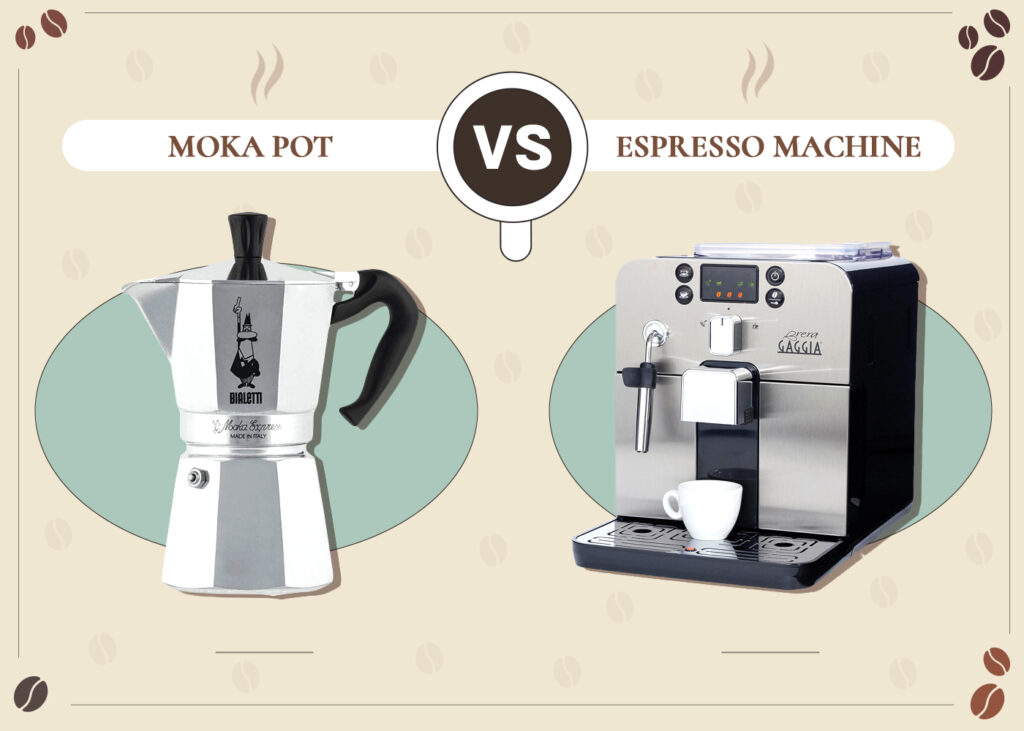
Making espresso at home gives you coffee shop quality coffee without having to wait in line. There are a few different ways to make espresso at home. Two of those options are Moka pots and espresso machines. Today, we are going to examine the main differences between the two and also the benefits and drawbacks of each. This will give you more information to aid you in making a decision on which to use in your home to make your favorite espresso drinks.

Moka Pot Basics

A Moka pot is a stovetop or electric espresso maker. These brewers have two chambers. In the lower chamber, you add water and fill the filter with coffee grounds. The upper chamber collects your brewed coffee.
To make espresso, you place a stovetop Moka pot over medium heat or turn on an electric model. When the water reaches boiling point, steam rises through the grounds and collects in the upper chamber. There, it condenses into rich, strong coffee. This process usually takes about ten minutes.
Benefits
The Moka pot is a simpler process. It’s easy to use (even for first-timers) and does most of the work for you. It can make multiple shots of espresso at once, depending on the Moka pot’s capacity. A 4-cup stovetop espresso maker will make four 2-oz cups of espresso.

Drawbacks
Moka pots can have poor extraction because they don’t use any pressure to force the water through the grounds—just steam from your stovetop. Every time you make it, another variable (from the heat to the amount of coffee) might be different. This can vastly change the way your espresso tastes. Another drawback is that it can have a metallic taste if you’re using an aluminum Moka pot. Some are stainless steel, which eliminates the potential for a metallic tint to the coffee.
- Simple process
- Multiple servings
- Inexpensive
- Metallic taste
- Quality can vary
- No crema

Espresso Machine Basics

Espresso machines are typically more complicated and expensive, though high-quality models will produce professional-grade espresso. These machines use pumps to push highly pressurized hot water through tightly packed (tamped) grounds. Depending on the model, you may need to tamp the grounds and time the shot yourself.
RELATED READ: Automatic vs. Semi-Automatic Espresso Machines: What’s the Difference?
Benefits
There is one major benefit to using an at-home espresso machine, and that’s the quality of the espresso. These machines use a higher amount of pressure that can create a more intense, richer espresso. Most quality espresso machines let the user have control over variables like time, temperature, and pressure. The machine controls these variables for you at a consistency that Moka pots often cannot reproduce.
With a good espresso machine, you’ll also be able to produce a delicious, rich crema. This aromatic red-brown layer of foam is considered a key component of an espresso shot.

Drawbacks
These machines are typically significantly more expensive than Moka pots. They can also differ vastly in operation depending on what model you buy, so you’ll need to spend time learning each machine. Espresso machines tend to require more practice to master the craft of making espresso.
Another drawback is that if you want to make multiple cups of espresso, it takes more time because you have to pull the shots individually—which takes on average 30 seconds per shot. Espresso machines can require quite a bit of maintenance, including replacing dull burrs, regular cleaning, and calibrating the temperature and pressure on occasion.
- Consistent quality
- Professional-grade espresso
- Plenty of crema
- More expensive
- More maintenance
- More difficult to master

Summary
We’ve just thrown a lot of information about espresso machines vs Moka pots at you. To make it easier for you to see the benefits and drawbacks, here is a quick summary.
Moka pots are easy to use, inexpensive, and can produce multiple servings at a time. On the negative side, they don’t produce full espresso and can leave a metallic taste. Espresso machines, on the other hand, produce high-quality, professional-grade espresso topped with a delicious crema. That is, if you know how to use them. You may need some barista training to get the most out of an espresso machine. Plus, they’re often pricey and require quite a bit of maintenance.
Which should you choose? That’s up to you!
RELATED READS:















